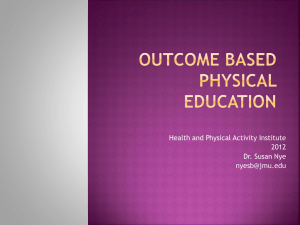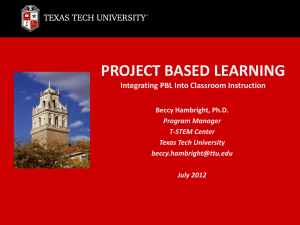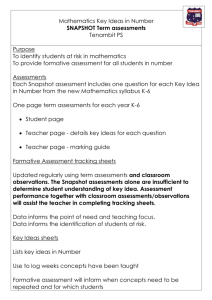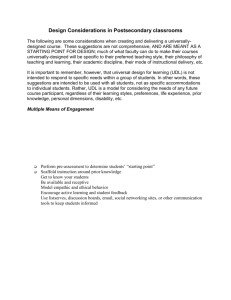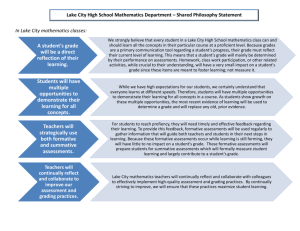Why Project Based Learning?
advertisement
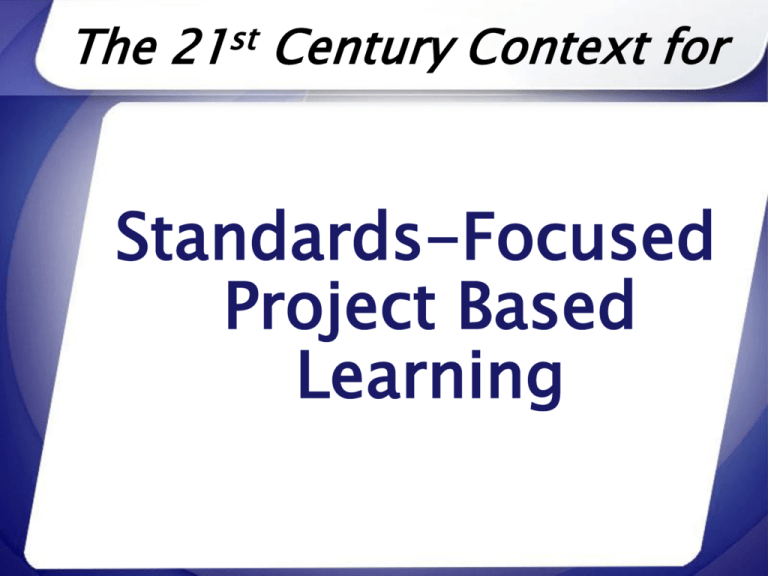
The 21st Century Context for Standards-Focused Project Based Learning Create a Balanced Assessment Plan Stage 2 Balanced Assessment Plan • Formative assessments that allow you to give feedback as the project progresses – Classroom Assessments for Learning • Classroom Assessments of Learning that provide students with a culminating appraisal of their performance Align products with Outcomes. Planning effective assessments requires that you work backwards to align the product or performances for the project with the outcomes. Align Products with Outcomes This requires: Identifying culminating products for the project Using multiple products and providing feedback to students Using artifacts – evidence of the process of student thinking – to assess learning skills or habits of mind Establish Performance Criteria • How well do the students know the content? • What is their skill level? • How well did they apply their knowledge and skills as they prepared their product? How will products allow students to demonstrate their learning? If the project asks students to demonstrate proficiency in three areas, each outcome must be assessed and included in one or more of the components of the products for the project. For example, You have identified: • Four (4) content objectives • Three (3)learning skills objectives • Two (2) technology tool objectives You may first decide the products students will produce: • Exhibition • Research paper • Journal Culminating Products • Research papers • Report to school staff or authentic audience • Multimedia shows • Presentations at school-wide assemblies • Exhibitions in the school or community • Websites • Public service announcements Advantages to using exhibitions • Participant involvement in establishment of criteria • Demonstration of progress toward different goals or criteria • Teamwork that provides emotional support and feedback • Exercises in meta-cognitive training • Students as knowledgeable practitioners • Multiple assessors A systematic set of checkpoints for project products will not only help keep students on schedule, but it will also help them refine and improve their work. Examples of multiple products • • • • • • Proposals Outlines Plans Blueprints Drafts Edited drafts revised drafts • models • Product critiques • Videos • Final versions of papers • Field guides • Biographies • Websites Artifacts • • • • • • • • • Notes Journal entries E-mail/Telephone records Records of conversations, decisions, revisions Interviews using a structured set of questions developed by the students Short reflective paragraphs describing the progress of a project Task chart Project Team Contract Meeting notes Know What to Assess • Unpack the content standards and objectives – Series of specific statements of what needs to be learned – Think about unpacking the task(s) – Define the “habits of mind” or learning skills and technology tools by specific statements or indicators ASSESSMENT PRACTICES ACADEMIC RIGOR ADULT RELATIONSHIPS AUTHENTICITY ACTIVE EXPLORATION APPLIED LEARNING ASSESSMENT PRACTICES Exhibitions of work Variety of assessment tools Professional standards of performance Student involvement in creating criteria for project (rubric) TRADITIONAL ASSIGNMENT RESEARCH PAPER Required Elements: Select a disease to study Go to library and do research Write ten pages Use proper essay form Include a bibliography PBL ASSIGNMENT HEALTH PROJECT Required Elements: Develop family medical histories Write proposal to study health issue of personal or community interest Keep research log, including citations Produce a newsletter Develop lesson plans and materials for underserved population Present to real audience TRANSFORMING PRACTICE Traditional Assignment PBL Assignment Student works alone Student works alone Context is school and in teams Context is family and community Assessment by real audience and teacher Assessment by teacher only WHY ASSESS? What role does assessment play in project-based teaching and learning? PURPOSES OF ASSESSMENT Help students become aware of areas of need Formative -- help students along the way, ongoing Proof of learning, growth Feedback helps create better product/project Opportunity to test depth of understanding Helps to define lesson design and performance Helps teachers determine what to reteach Allows for natural adult connections Helps to share the workload Checkpoint for integration DESIGN FOR ASSESSMENT Traditional Approach: CONTENT PLAN INSTRUCTION INSTRUCTION PLAN ASSESSMENT ASSESS Outcome-Based Approach: OUTCOME PLAN ASSESSMENT PLAN INSTRUCTION INSTRUCTION ASSESS BALANCED ASSESSMENT COLLECT EVIDENCE AT VARIOUS STAGES OF THE WORK USE A VARIETY OF METHODS: Tests Product assessments Performance assessments Self-Reports FORMATIVE ASSESSMENT In-Process Feedback: WHEN? WHO? Key considerations: Frequency, Timing, & Who Gives Feedback START END Curricular Priorities and Assessment Methods Traditional quizzes and tests (selected response)……. Quizzes and tests (constructed response)……. Performance tasks and projects… Performance tasks and projects (complex, open-ended, authentic)……... PBL FRAMEWORK PROJECT ASSESSMENT & EVALUATION CURRICULUM DESIGN Stage 3 RESOURCES & CONSTRAINTS The Rigor/Relevance Framework K N O W L E D G E T A X O N O M Y Evaluation 6 Synthesis 5 Analysis 4 Application 3 Understandin 2 g Awareness 1 C Assimilation D Adaptation A Acquisition B Application 1 Knowledge 2 Apply in discipline APPLICATION MODEL 3 Apply across disciplines 4 Apply to real world predictable situations 5 Apply to realworld unpredictable situations

